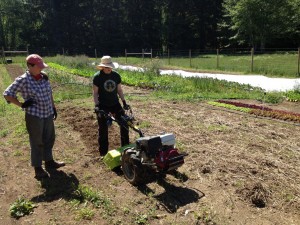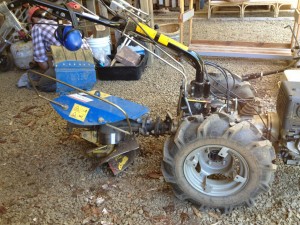So, for quite a while we’ve been toying with the idea of a two wheeled tractor. What on earth is that, you ask? Well, it looks kindof like a rototiller on steroids, and performs most of the same service as its four-wheeled cousins. Although not seen much in the US, they are fairly popular on small scale farms in Europe. Two-wheeled tractors have interchangeable implements, much like “regular” tractors, and can do a wide range of farm chores: tilling, plowing, reaping, mowing, chipping. They even make specialist attachments for odd jobs like snow blowing and combining. Our farmer buddy Carolina (of Corvus Landing Farm) has been using one for years, and is an expert, so we were finally able to take her up on the offer to have a “tractor demonstration day” at her farm after talking about it for over a year.
 Here we see Carolina instructing Emily on the proper use and technique of the two-wheeler. It’s quite an instrument, with tons of controls on the handles: split brakes, clutch, differential disengage, 4-speed transmission, reverse gear, throttle. There are also two levers to adjust the angle and elevation of the control yoke. This is handy, as you sometimes need to be off to the side of the tractor, depending on the task and implement you are using.
Here we see Carolina instructing Emily on the proper use and technique of the two-wheeler. It’s quite an instrument, with tons of controls on the handles: split brakes, clutch, differential disengage, 4-speed transmission, reverse gear, throttle. There are also two levers to adjust the angle and elevation of the control yoke. This is handy, as you sometimes need to be off to the side of the tractor, depending on the task and implement you are using.
Emily and I took turns plowing and tilling portions of Carolina’s fields. It was fun, and while working and talking with Carolina, many of the advantages of this tool soon became apparent. In two hours, we were able to completely prep soil on an area the size of our entire garden, for starters. That is a task that would normally take WEEKS by hand. We also burned about half a gallon of gasoline to do it, which is amazingly efficient. The machine is efficient in other ways, too- it’s a fraction of the cost of a full-size tractor, has very low maintenance requirements, and is simple enough that all the maintenance can be done by the farmer. From an operational standpoint, its size makes it easy to maneuver in the sorts of tight spaces that small-scale vegetable growers like ourselves have to work in, and you don’t need a giant barn to store it out of the weather. But best of all? You farm with your feet on the ground. It may sound hippy-dippy, but it just feels like real farming. Good exercise too, and no way to fall asleep in the seat and get munched by your own equipment.
 One other great thing about this machine is an implement called a “rotary plow.” It’s unique to this type of tractor, and works much like a moldboard plow, but it has a vertical spinning shaft with an auger. This makes it turn up a LOT of dirt, without packing down a hardpan 18 inches below the soil like a moldboard would. It also makes great rows and raised beds. Here’s a video of Emily running the rotary plow.
One other great thing about this machine is an implement called a “rotary plow.” It’s unique to this type of tractor, and works much like a moldboard plow, but it has a vertical spinning shaft with an auger. This makes it turn up a LOT of dirt, without packing down a hardpan 18 inches below the soil like a moldboard would. It also makes great rows and raised beds. Here’s a video of Emily running the rotary plow.
But, like all things, it has some disadvantages. It has enough power to do all the things we’d need, but no extra for things that might come up in the future, like hauling logs out of the woods, moving vast piles of compost, or dragging skid buildings around. And speaking of moving, it has no front loader. That is the biggest negative everyone comes up with when we talk about these things, and Carolina admitted that she really wishes she had that utility. Getting used implements is impossible, because two-wheelers are uncommon, but three-point implements for more traditional tractors can be found on the used market everywhere… making this one aspect where four-wheelers are cheaper.
We still haven’t settled on what we’re going to do, but we need to start thinking about some degree of mechanization if we are going to successfully expand our business. Luckily, we don’t have to act on this for several months, so there will be plenty of time to ponder it. Hopefully, while looking at something peaceful like this.


